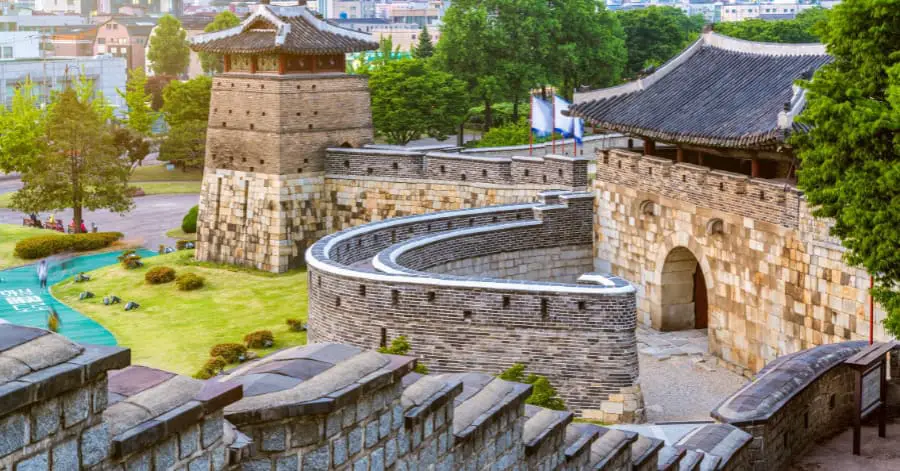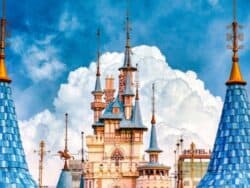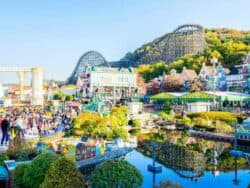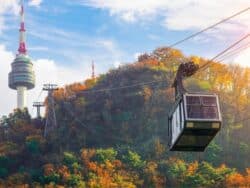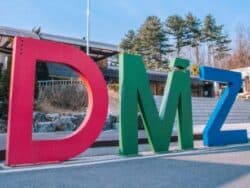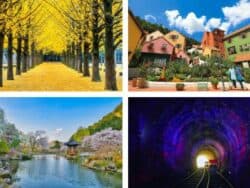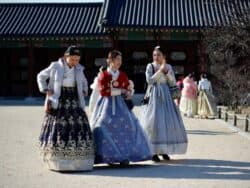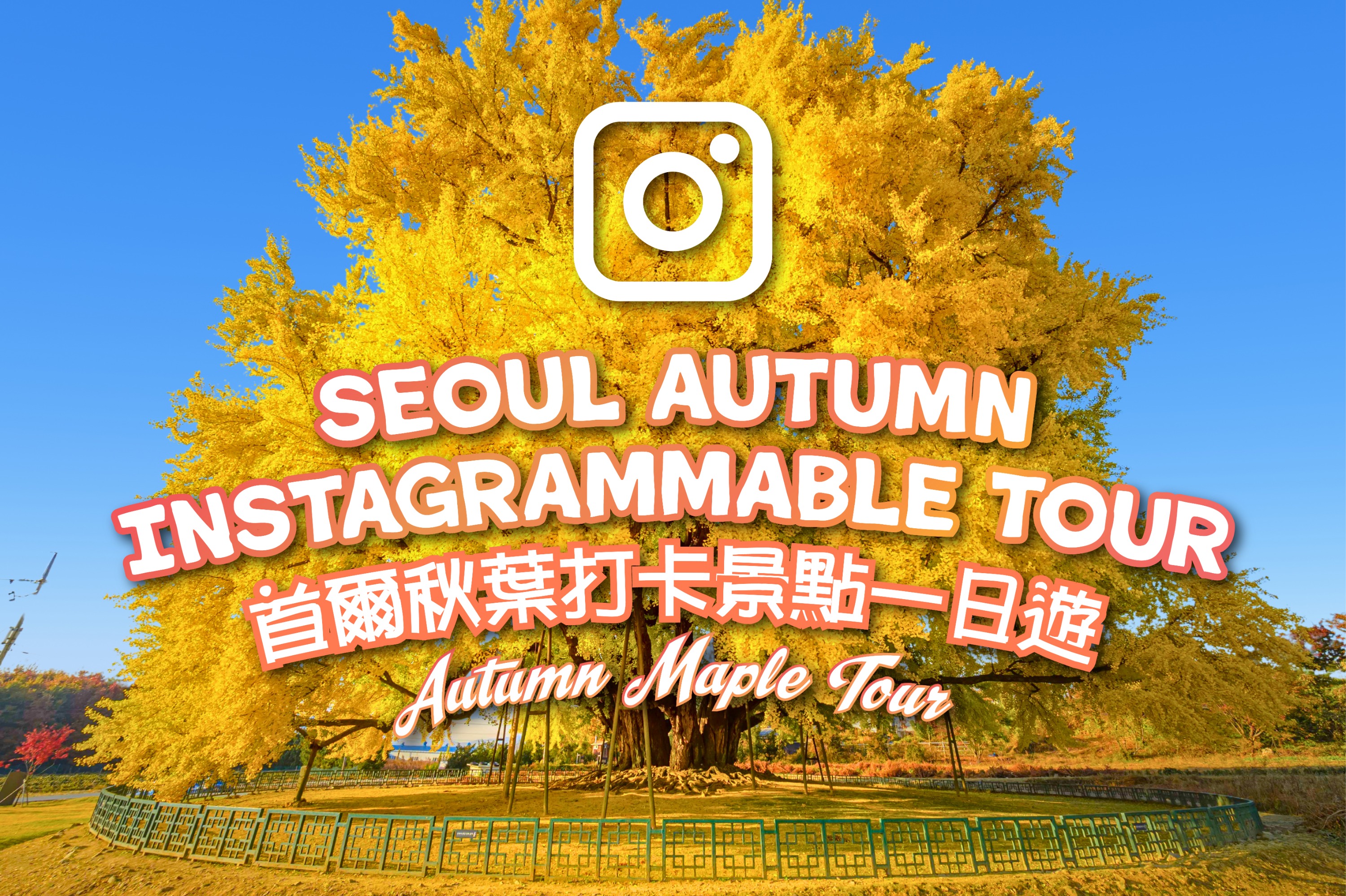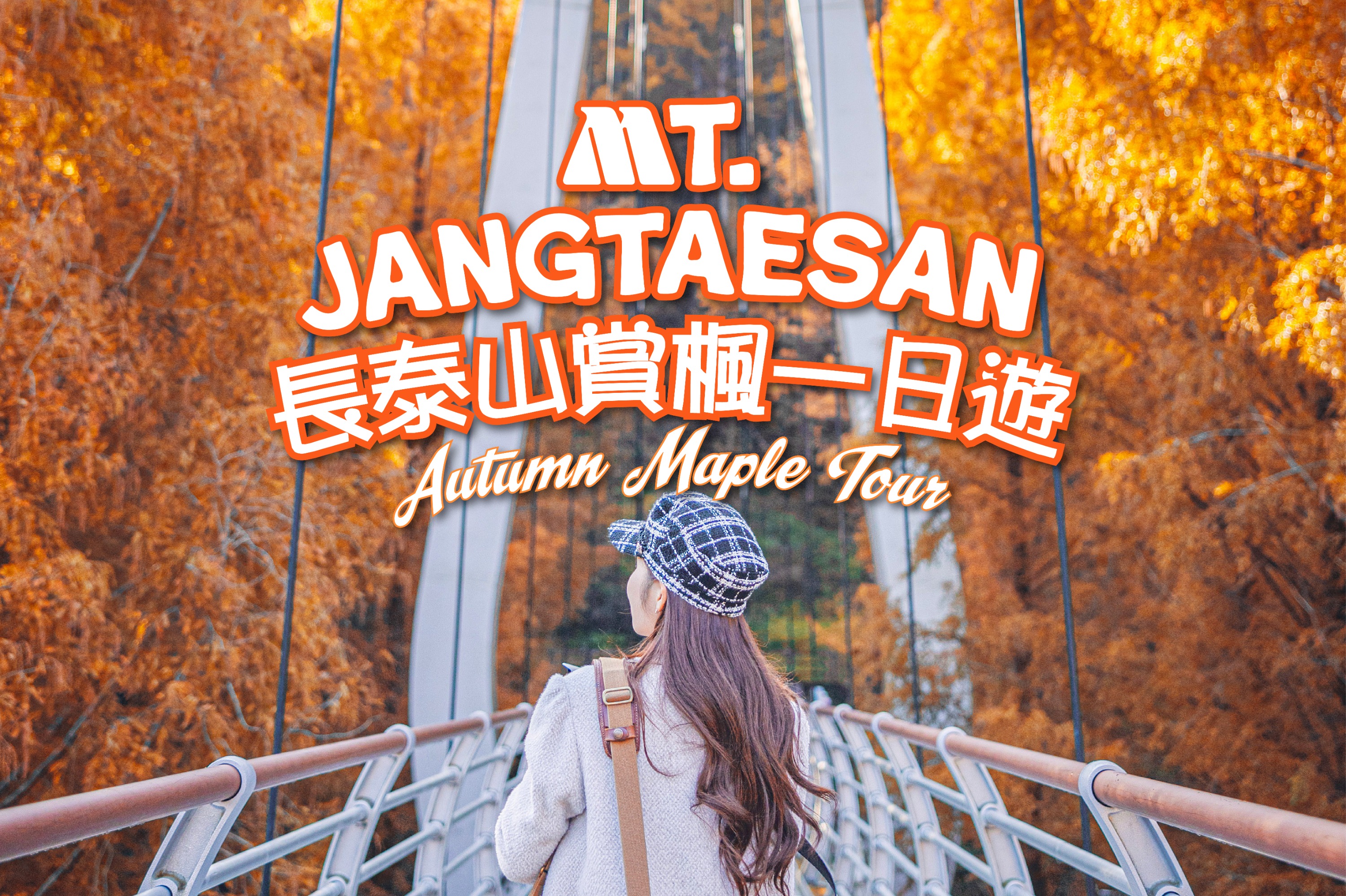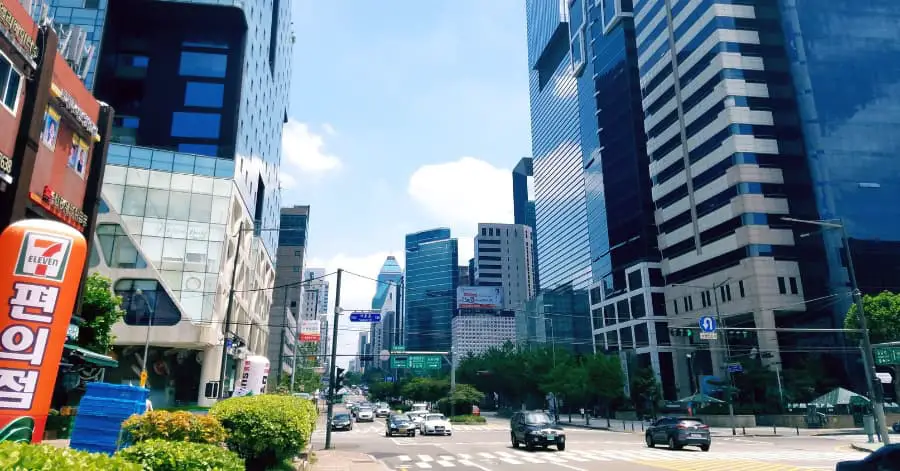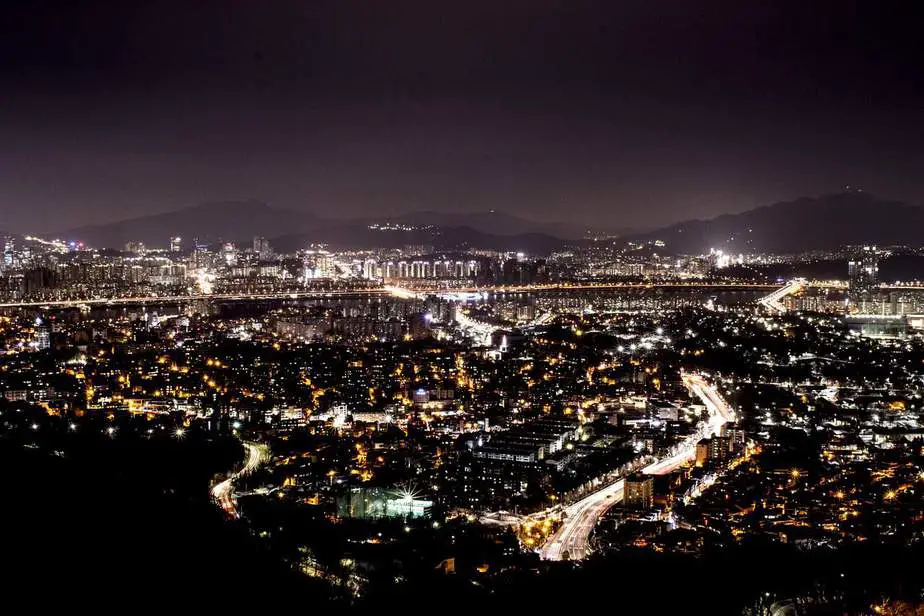📍 Suwon Hwaseong Fortress Address: 경기 수원시 장안구 영화동 320-2 | 320-2 Yeonghwa-dong, Jangan-gu, Suwon-si, Gyeonggi-do, South Korea
🚆 Seoul Station -> Suwon Station: ITX Train / Mugunghwa Train / KTX Train. From Suwon KTX Station, exit the building via Exit 1 and take the escalator on the left to get to Suwon Hwaseong Fortress.
🕒Summer Season (March to October): 9:00 AM – 6:00 PM | Winter Season (November to February): 9:00 AM – 5:00 PM.
₩ From ₩300 (≈ $0.22) to ₩6,500 ($4.73), depending on the destination.
☎️ +82-2-3668-2300
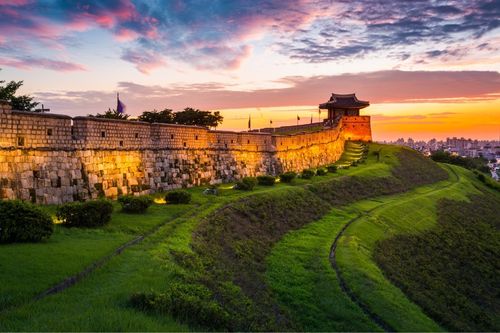
✍🏻 The best way to experience the fortress is by walking along its walls. Begin your visit to Paldalmun Gate. You can ring Hyowon’s Bell at the summit of Paldalsan Mountain within the fortress grounds. The best time to visit is during spring or autumn to avoid the extreme summer and winter temperatures.
You May Also Love:
- Suwon Hwaseong Fortress Day Tours from Seoul
- Suwon Hwaseong Fortress Night Tours
- Suwon Hwaseong Traditional Market and Hot Air Balloon Flight Experience
- Korean Folk Village Tour, Suwon Hwaseong & Anseong Farmland from Seoul
- Cherry Blossom Suwon Hwaseong Fortress Tour from Seoul
- Suwon Hwaseong Fortress and Korean Folk Village Day Tour from Seoul
- 12 Top Attractions and Things To Do in Suwon
How to get to Suwon Hwaseong Fortress
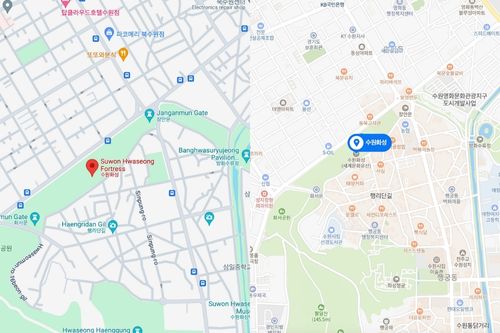
Address: 경기 수원시 장안구 영화동 320-2 | 320-2 Yeonghwa-dong, Jangan-gu, Suwon-si, Gyeonggi-do, South Korea
By Subway
Starting at Seoul Station, take Subway Line 1 to Suwon Station, about 53 minutes away, to reach Suwon Hwaseong Fortress. There are several bus stops at Suwon Station, from which you can take the bus to the destination.
- Take #31, #7-1A, #7-2, #66, #66-4, 60, #82-1, #301, #310, #400A, #777
- Or #900 from Bus Stop 1 near Exit 7; after approximately 9 minutes, you’ll get off at the Jangan Park stop.
For an alternative that similarly takes about 9 minutes, you can take Bus #1007, 2007. Or 7770 from Bus Stop 2, across the underpass from exit 4.
By Train
Depending on your travel preferences, there are three main train alternatives from Seoul to Suwon Station:
- Option 1, with the Korail Mugunghwa Train, takes around 36 minutes and costs around ₩2,700 (USD 2.30).
- Option 2 with Korail ITX Train, which takes just 31 minutes and costs about ₩4,800 (USD 4.10).
- Option 3 with the KTX Train is the quickest alternative if time is critical; it arrives at Suwon Station in about 25 minutes (₩8,400 (USD 7.15)).
By Bus
There isn’t a direct bus service from Seoul to Suwon Hwaseong Fortress, but there is a simple route that requires one transfer. Take a bus from Exit 5 of Seoul’s Gangbyeon Station to begin your journey. The journey to Dunjeon Station usually takes about 1.5 hours. After you reach Dunjeon Station, you should transfer to bus 5700A, heading towards Everland. This portion of the trip will take around 40 minutes.
You can get out near the Hwaseong Fortress entrance at the Dongsuwon Sageori stop. A rechargeable transit card called T-money can be helpful in your journey because it can be used on buses, subways, and taxis all around South Korea, not just in Seoul. Any Seoul convenience store will sell T-money cards. You should expect to pay about ₩4,000 (about $3.40) for the bus ride from Gangbyeon Station to the fortress.
By Car
One of the most enjoyable ways to see the beautiful Korean countryside is a road trip from Seoul to Suwon Hwaseong Fortress. Regarding navigation, two trustworthy Korean apps, KakaoNavi and Naver Maps, can make your driving experience far better than what Google Maps can offer. The drive usually takes around 30 minutes and covers about 39 kilometers, though it can go longer or shorter depending on traffic.
Possible Parking Solutions: Although it can get busy, particularly on weekends, the Hwaseomun Gate Parking Lot is conveniently located next to the gate and is easy to access. The hourly parking rates might be anything from 1,000 to 2,000 ₩. An additional practical parking option near Paldalmun Gate that offers comparable pricing is the Paldalmun Gate Parking Lot.
The best option:
For several reasons, the Seoul Subway to Suwon Station is the most convenient route to Suwon Hwaseong Fortress. It is accessible to locals and visitors because of its well-connected system and user-friendly layout. Thanks to Subway Line 1, you may skip the hassle of changing trains between Seoul and Suwon.
A brief history of Suwon Hwaseong Fortress (수원화성)
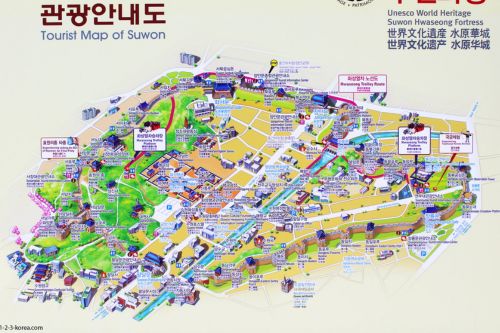
Located in the southern part of Seoul in Suwon, the stately Suwon Hwaseong Fortress is a monument of the Joseon Dynasty’s brilliance and vision. Built between 1794 and 1796 by order of King Jeongjo, this massive structure served as a defensive stronghold and an ambitious urban development project to honor Crown Prince Sado, King Jeongjo’s father, and promote Suwon as a new commercial hub. In 1997, the Hwaseong Fortress was named a UNESCO World Heritage Site. The fortress covers over 6 kilometers and includes the heart of Suwon City.
Its walls are solid and well-thought-out, incorporating various groundbreaking scientific and defensive technologies from that period. It is a masterpiece of military construction from the 18th century, with four massive gates facing in all directions and many amenities like floodgates, observation towers, command posts, and secret gates. The Hwaseong Seongyeok Uigwe, a thorough record of its construction published in 1801, exhaustively documents the design’s reflection of a substantial European and East Asian influence.


Best Things to See in Suwon Hwaseong Fortress
Suwon Hwaseong Fortress (수원화성)
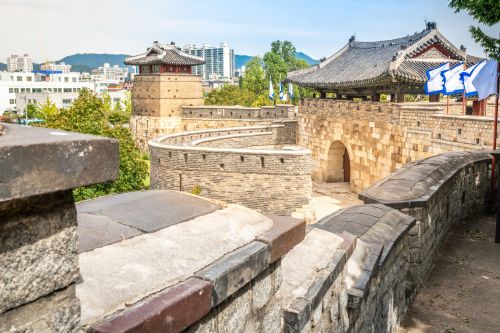
Not only is Suwon Hwaseong rich in historical artifacts and ancient stones, but it is also bustling with colorful cultural festivals that will transport you to a bygone era. An annual King Jeongjo Tomb Parade recreates the regal procession of King Jeongjo to his father’s tomb in Hwaseong, and the Suwon Hwaseong Cultural Festival captivates audiences with reenactments, traditional music, and dance performances. The Suwon Jazz Festival and the Suwon Theatre Festival offer a taste of new art to this historic venue, appealing to people who appreciate a touch of modernity.
Plus, the region surrounding Hwaseong is rich in history and culture, not only because of the fortress. You will enjoy a leisurely tour of the grounds on the Hwaseong Fortress Tourist Trolley or see the Suwon Haenggung Palace, a former temporary residence of monarchs, within the fortress walls. The fortress comes alive at night as lights illuminate its walls, painting a captivating scene of the historic fortifications against Suwon’s busy cityscape.
Paldalmun Gate (팔달문)
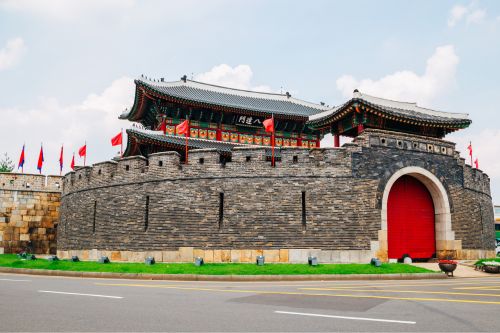
Hwaseong Fortress’s southern sentinel, Paldalmun Gate, is no ordinary gate. Here, you can enter a realm where history gracefully intertwines with the present; it’s more than just a doorway. An architectural wonder in and of itself, the gate is grander and more expansive than its northern analog. The entrance is large enough to accommodate the palanquin of a king easily. A majestic watchtower perched above this royal entrance has guarded the territory below for generations.
The exquisite craftsmanship of the late Joseon Dynasty is on full display in the Paldalmun Gate. Among other similar constructions in Korea, its crescent-shaped ongoing barrier wall stands out for its beauty and grandeur, providing defense against invaders. Recognized as a masterpiece of period castle design, the gate’s watchtower boasts a hip roof and elaborate ornamentation. Every season brings unique events to the region, turning a stay here into a thrilling adventure.
As you travel around Suwon and Korea, you will see more of the country’s stunning architecture. Other notable gates are Janganmun Gate (장안문), Hwahongmun (화홍문), Banghwasuryujeong Pavilion (방화수류정), and Hwahongmun Gate (화홍문).
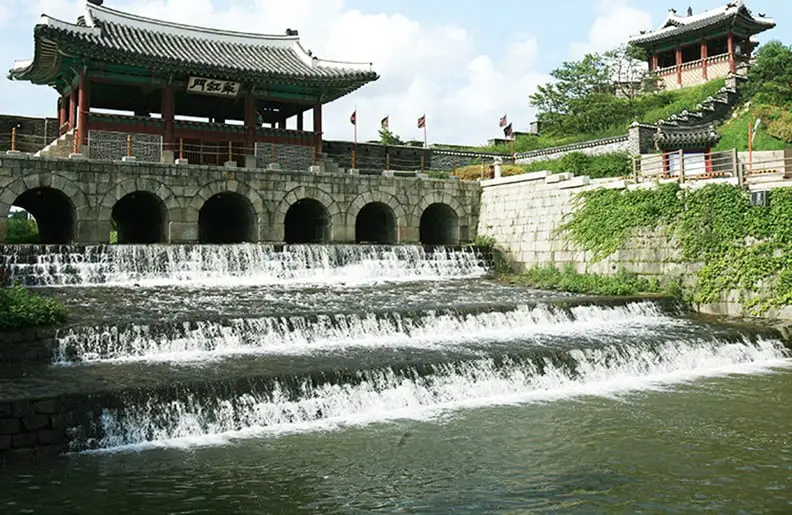
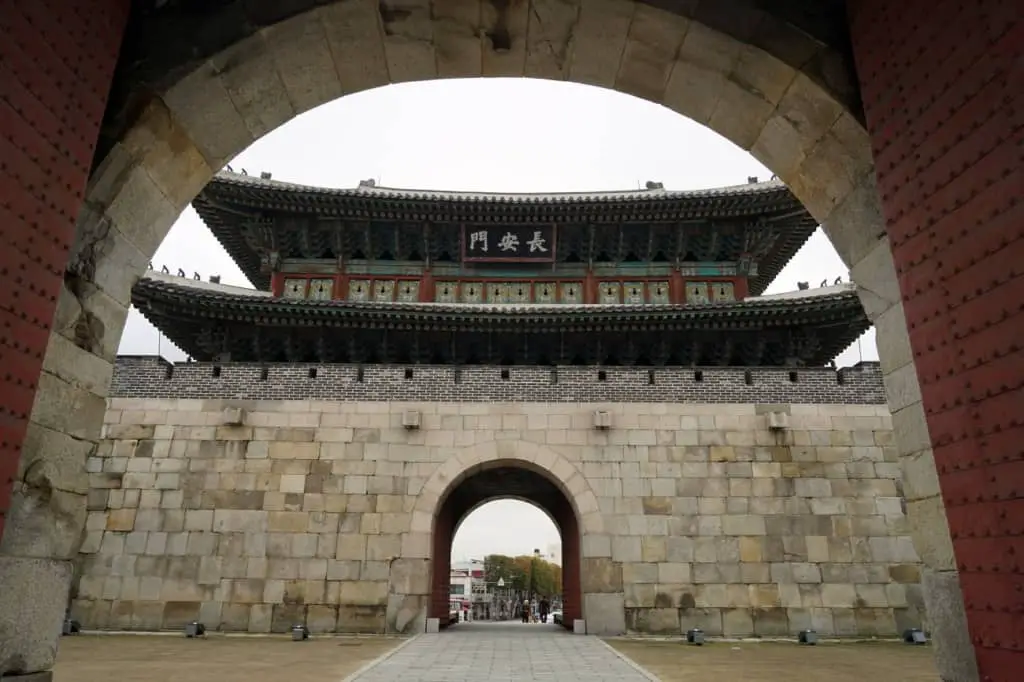
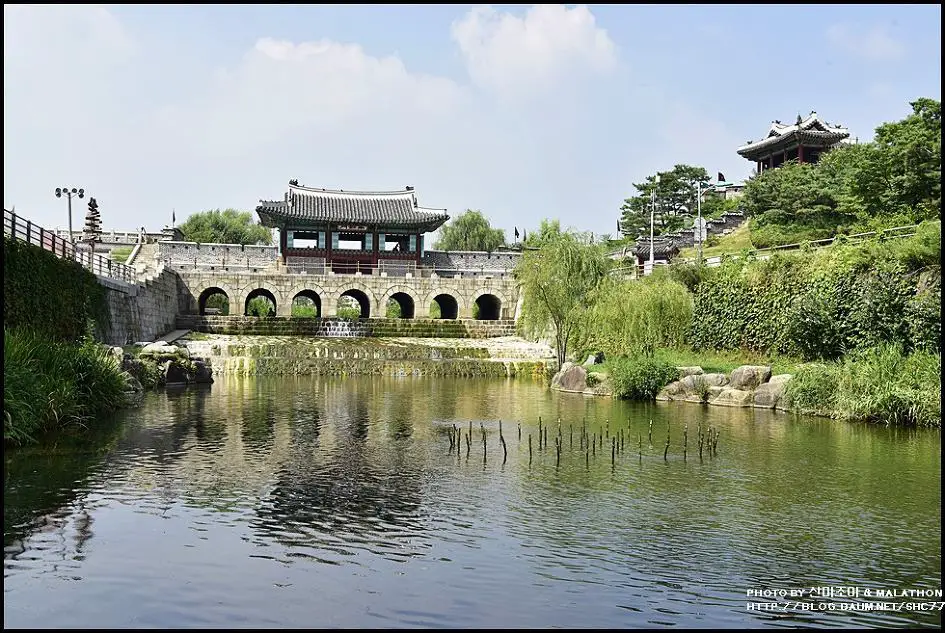
Hwaseong Haeggung (화성행궁)
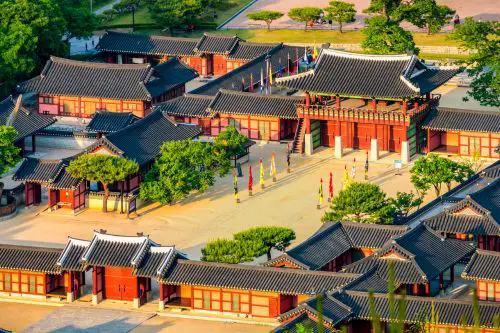
Hwaseong Haenggung Palace, the biggest of its sort utilized during the Joseon Dynasty, is nestled amid the historical beauty of Hwaseong Fortress. Whether calm or chaos was in the air, this magnificent palace was always a haven for the royal family and their lively court. If you find yourself in Suwon, you must stroll through Haenggung.
More than merely a royal residence, Hwaseong Haenggung hosted pivotal moments in Korea’s illustrious royal past. Imagine strolling around the grounds where King Jeongjo personally planned a lavish celebration for his mother’s 60th birthday or where daring military plans were hatched amidst breathtaking architectural backdrops. Rooms that have witnessed such a fusion of festivity and strategy are rarely encountered.
From April through October, every Sunday, the Jangyongyeong guard ritual is held at the front gate. It is a display of military force and precision that you should not miss. You can feel the grandeur and ceremonial of the Joseon era’s military customs up close and personal.
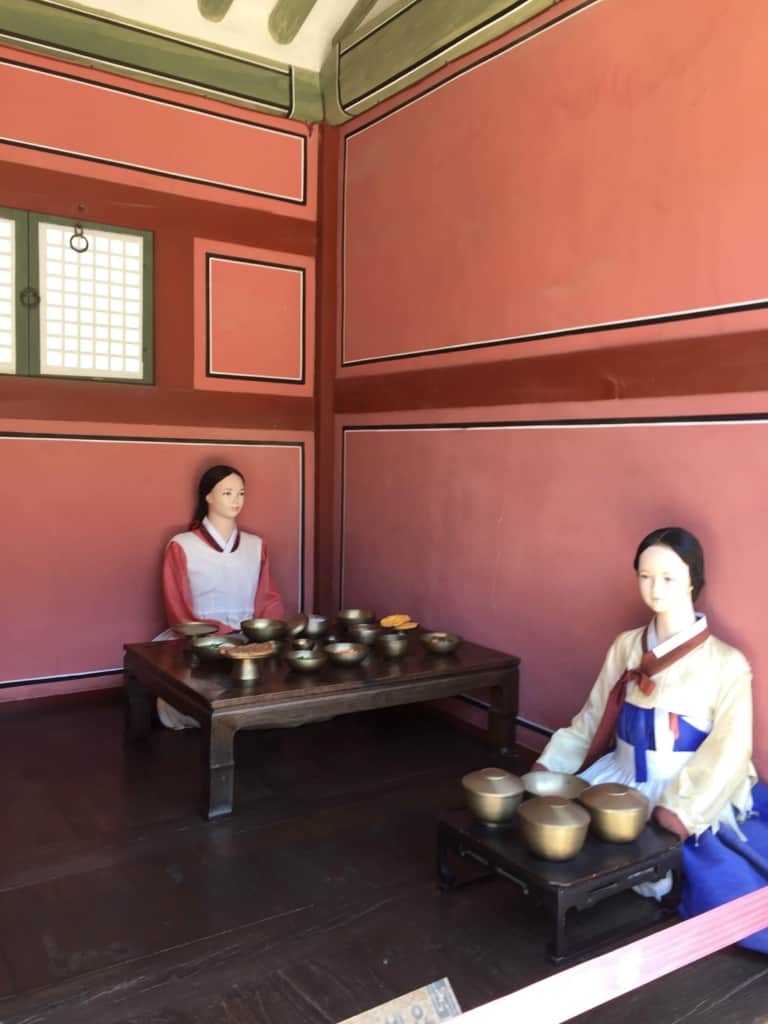
Like many other historical sites all over Korea, Suwon Hwaseong Fortress offers the opportunity to wear traditional dress. While wearing the hanbok, you can take photos in front of numerous sites. For many people, this is what makes Suwon Hwaseong Fortress one of the best day trips to Suwon from Seoul.
Ticket Prices
Hwaseong Fortress Tour Information
| Classification | Children (KRW / USD) | Youth and Military Soldiers (KRW / USD) | Adults (KRW / USD) |
|---|---|---|---|
| Individual | 500 / $0.37 | 700 / $0.52 | 1,000 / $0.74 |
| Group (20+ people) | 300 / $0.22 | 500 / $0.37 | 700 / $0.52 |
Hwaseong Haenggung (Temporary Palace) Tour Information
| Classification | Children (KRW / USD) | Youth and Military Soldiers (KRW / USD) | Adults (KRW / USD) |
|---|---|---|---|
| Individual | 700 / $0.52 | 1,000 / $0.74 | 1,500 / $1.11 |
| Group (20+ people) | 500 / $0.37 | 800 / $0.59 | 1,200 / $0.89 |
Integrated Viewing (Suwon Hwaseong, Hwaseong Haenggung, Suwon Museum, Suwon Hwaseong Museum)
| Classification | Children (KRW / USD) | Youth and Military Soldiers (KRW / USD) | Adults (KRW / USD) |
|---|---|---|---|
| Individual | 800 / $0.59 | 2,000 / $1.48 | 3,500 / $2.59 |
| Group (20+ people) | 600 / $0.44 | 1,200 / $0.89 | 2,000 / $1.48 |
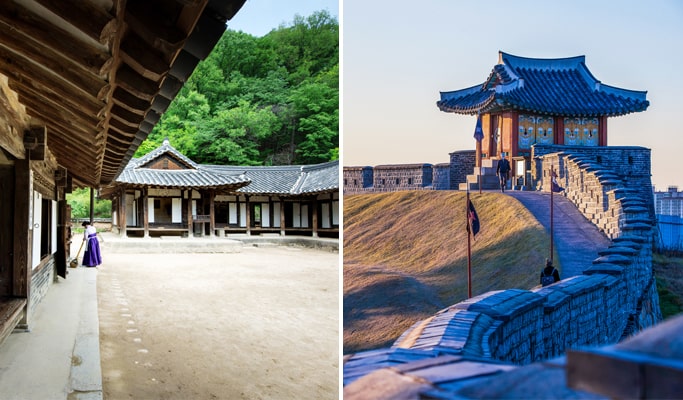


Nearby attractions
Korean Folk Village (한국민속촌)
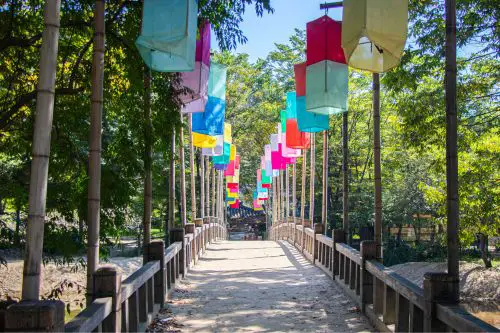
- Address: 90 Minsokchon-ro, Giheung-gu, Yongin-si, Gyeonggi-do, South Korea
- Opening hours: Friday through Sunday, the establishment is open from 10 AM to 10 PM. However, starting Monday and continuing through Thursday, the hours change to 10 AM to 6:30 PM.
- How to get there: Take the subway to Sanggal Station (상갈역) on the EverLine (에버라인). Upon arriving, exit through Exit 3 and walk straight for approximately 50 meters to the nearby bus stop. From there, you can catch either bus #100 or #5700, which operate every 15-20 minutes. Ride the bus to the 민속촌입구 (Minssokchon Ipgu) bus stop. The entrance to the Korean Folk Village is conveniently located just a 5-minute walk from this stop.
Make time in your itinerary to visit the Korean Folk Village in Yongin if you’re planning a trip to the land of kimchi and K-dramas. You can take a giant leap into Korea’s illustrious past at this magnificent recreation of a Joseon Dynasty village. Why, then, should you consider visiting this cultural treasure? It is enlightening and thrilling to remember a period when vibrant hanboks danced in the wind and traditional folk music and equestrian martial arts filled the air.
The Korean Folk Village is an excellent place for history aficionados and culture vultures to stroll through rebuilt homes from the late Joseon era. The houses display architectural and cultural details that will captivate visitors. And here’s something interesting for all you historical K-dramas fans: this village has been the setting for some amazing shows, like “My Love from the Star” and “Moon Embracing the Sun.” Yes, you will be strolling through the sets of your beloved television series!
For your interest, I’ll leave a video on how to play yut.
Manseok Park (만석공원)
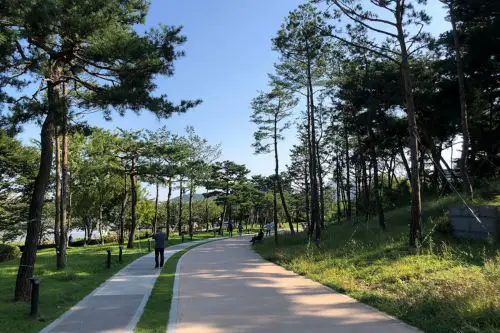
- Address: 434 KR, Songjuk-dong, Suwon-si, Gyeonggi-do, South Korea
- Opening hours: 24/7
- How to get there: Depending on your location, you can take several buses from Suwon Station. Buses 36, 65-1, 96, and 502 all go to the park.
A beautiful park isn’t the only thing Manseok Park has to offer; its facilities may transform a dreary day into an exercise extravaganza. Do you want to go for a run or a leisurely walk? Take a spin around a tranquil reservoir on the 1,200-meter track. This track will become your trusted companion whenever you’re on two wheels, whether it’s a bike or your feet. In addition to a skate park that every skateboarder’s fantasy would be complete with rails to grind and airs to pop, the park is home to Korea’s highest public half-pipe.
In June, the park becomes a culinary haven for the Suwon Galbi Festival. You can indulge in traditional Korean cuisine and a shot or two of soju at this lively spot, where many pojangmacha (street food tents) set the mood. In addition, historical connections should be noted. During the 2002 FIFA World Cup, Manseok Park transformed into the Suwon World Cup Park. Manseok Park in Suwon offers an unparalleled combination of leisure, culture, and pure pleasure, whether you’re into sports, snacks, or a great day in the sun. Gather your picnic supplies, apply some sunscreen, and discover why this park is so important to the people of Suwon!
Gwanggyo Lake Park (광교호수공원)
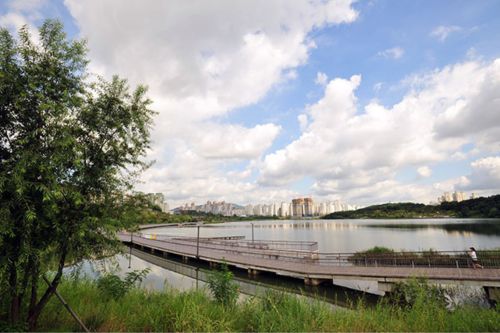
- Address: 102 Gwanggyohosu-ro, Ha-dong, Yeongtong-gu, Suwon-si, Gyeonggi-do, South Korea
- Opening hours: 24/7
- How to get there: Several buses from Suwon Station go to the park. These include buses 36, 65-1, 96, and 502.
In the heart of Yeongtong-gu, Suwon is Gwanggyo Lake Park, a picture-perfect sanctuary that offers a much-needed escape from the hustle and bustle of nearby cities. This hidden gem is a must-visit for any traveler to South Korea due to its breathtaking scenery and abundant activities. A visual feast that would calm even the most troubled spirits, it boasts expansive vistas of the tranquil Gwanggyo Lake surrounded by verdant foliage. The 33-meter-tall Freiburg Observatory also deserves mention; it provides breathtaking panoramas that will make your Instagram followers green with envy.
Something different about Gwanggyo Lake Park is that it’s near the area of Gwanggyo, which is pretty urbanized; if you ever feel like you need to get back to society, it’s only a 5-minute walk from Gwanggyo Lake Park. There are two big department stores close to Gwanggyo Lake Park, Galleria and Korea’s megastore Lotte Department Store. Both Manseok Park and Gwanggyo Lake Park serve as two of the biggest recreation sites, and because of this, they are a couple of the best day trips to Suwon from Seoul.
Final thought
The Suwon Hwaseong Cultural Festival, usually held in October, is a once-a-year extravaganza that brings the fortress to life with mesmerizing performances, parades, and fireworks—the perfect blend of recreation and education. At this time of year, the castle is most spectacular when decorated for the holidays.
Whether you love history and photography or enjoy walking in beautiful scenery, Suwon Hwaseong Fortress provides an unforgettable experience combining cultural immersion, historical exploration, and stunning vistas. Gather your belongings and your camera because you are about to see one of South Korea’s most prized attractions. Your Instagram feed will be eternally grateful, I promise.
IVK’s Top Picks – Day Tours, Tickets, and Travel Activities
Seasonal Picks!😍


